It didn’t take long for the gushing to begin after Tyler Reddick’s Homestead win. Heck, it even started before his final passes of P2 Denny Hamlin and leader Ryan Blaney for the win.
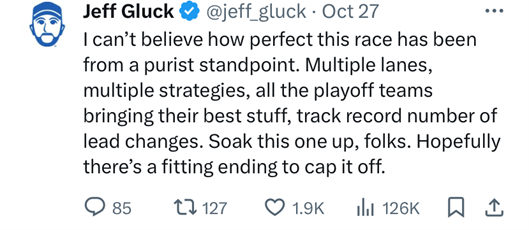
When Reddick went to the wall to blow by leader Ryan Blaney in Turn 3 of the final lap and hold on for his third win of the season, the social media accolades started flying…
Jeff’s assessment was seconded by fan after fan on social media. Greatest Playoff Race. Ever.
Shortly after the loop data stopped sizzling, NASCAR personnel posted the record-breaking numbers:
The fans spoke by giving it a 93.8% YES in the Jeff Gluck’s “Good Race Poll”. It was the third highest of the season behind the first races at Atlanta and Kansas, which blew a 95.8 and 94.8 respectively.
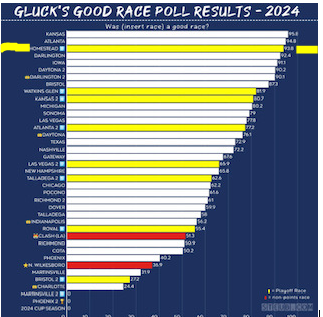
By all accounts, it must be the Greatest Playoff Race, Ever.
But if you’ve followed me for a while, you know we dig deeper into the numbers to see if they are really saying what they seem to be saying. Let’s start with the Lead Changes.
Track Record Lead Changes with 33
Sure was. Never been more than that at this track. But when you hear that, what do you think? P2 raced past P1 on the track under green flag conditions, just like Tyler Reddick did in Turn 3 of the last lap to take the lead from Blaney, just repeated 33 times. That’s what I think when I hear it. Betcha, you do as well. And when you hear it, you must breathlessly agree – incredible race. And no talking head is going to tell you any different when they gush about it either.
But maybe when you look deeper, you might take your foot off the matted gas pedal and consider pumping those Greatest Race breaks a little bit.
Yes, there were 33 Lead Changes for the race among 11 different drivers.
But nine (9) of those 33 Lead Changes took place during the 6 cautions. Like when Blaney pitted on lap 257 and gave up the lead to Reddick who stayed out and inherited the lead. Not quite the same.
So now we’re down to 24 Green Flag Lead Changes. Still impressive but wait, there is more.
12 of those Green Flag Lead Changes took place during two Green Flag Pit Cycles, when varying pit strategies caused the leader to pull off the track to pit and relinquish the lead to a trailing car. So, half of the Green Flag Lead Changes weren’t from cars racing past one another, just swapping the point because the leader pitted.
That still leaves 12 Green Flag Lead Changes which isn’t bad.
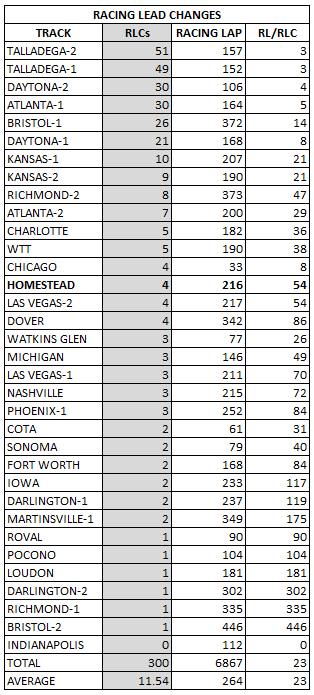
Eight (8) of those 12 Green Flag Lead Changes came about during the first three laps following the Race Start or Restart, when the field is packed up double file, like when Denny Hamlin took to lead from Reddick on the first lap of the final restart. It’s exciting for sure, but the circumstances contributing to those lead changes is hardly the same as what Blaney did on the next to last lap when he passed Hamlin or what Reddick did to Blaney in Turn 3 of the final lap.
So as exciting as those Restart Lead Changes are, we can agree, can’t we, they aren’t quite as exciting as what we think of when we first hear 33 Lead Changes. Heck, as fans at the track, we’re standing for the Restart anyway, these don’t make us stand up more. Not like a Racing Lead Change several more laps into a run.
Racing Lead Changes Tell a Different Story
That leaves us with what we all think of when we hear Lead Changes – Racing Lead Changes. P2 races past P1 during green flag laps without benefit of the bunching of starts and restarts or the leader pulling off the track to pit.
Overtakes, so to speak.
When you look at the Racing Lead Changes (RLCs) we’re left with 4. Not 33, but 4. All considered, still a decent number. For the races this season it’s midpack. tied for 13th with Chicago, Las Vegas the week before (which was a fuel mileage race that scored a 65.9%) and Dover.
So, to bring it back in, here is the Lead Change and Passing Summary for Homestead.
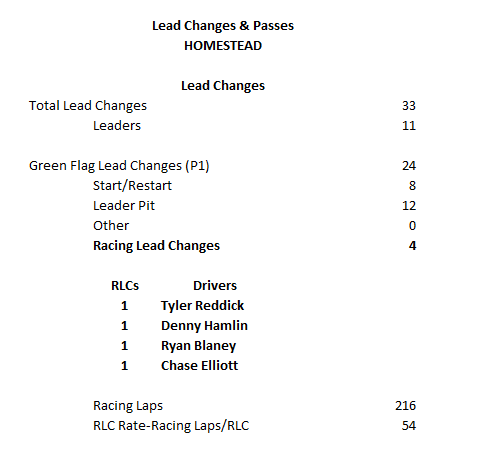
With these four additional RLC’s for these drivers, the RLC Standings is as follows with Joey Logano still atop that Leaderboard, but Hamlin pulling into a tie with Kyle Larson, who did not make a single RLC in this round so far.
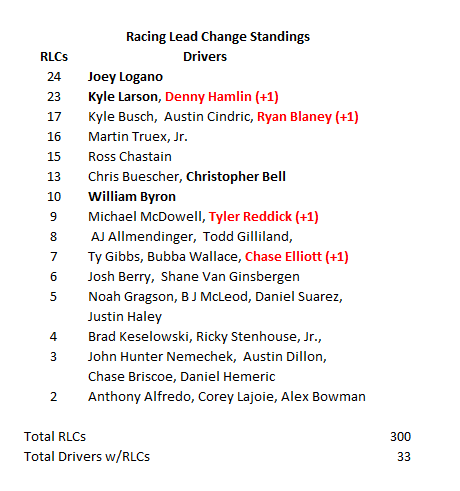
What About All Those Other Green Flag Passes?
Another record for the race was the 6056 Green Flag Passes. This was over 2600 more passes than the race last year and more than double from the first GEN-7 Race here.
NASCAR uses this metric as an indicator of good racing, and it can be. High numbers in this category can also be a result of passes due to Green Flag Pit Stops, a phenomenon we see that at long, green flag run tracks like Richmond. No one is passing on track, but they still produce high passing numbers, inflated due to pit cycle position changes. It would take more time to perform the additional analysis to confirm, but considering the effect that Pit Stop Cycles had on the Lead Changes, there is a strong indication that these numbers were a caused by the Pit Stop Cycles, rather than Racing.
Does Quality Passes Show Us Anything?
I found it interesting that when NASCAR started rattling off all the track records in this race, Quality Passes (Green Flag Passes in P1-P15) was not mentioned. The 2024 version of Homestead had 1626 Quality Passes, which was almost 450 more than 2023 and a whooping 600 more than in the 2022 race. Since these are more desirable passes at or near the front you would think their sizeable increase would be shouted from the roof-tops, but for some reason it’s not. Why?
Could it be that if you talk about the high number of Quality Passes (P1-P15) it will draw attention to the fact that the bulk of the Green Flag passes took place P16+, back where they get little attention? In this race 4430 were P16+ passes as opposed to 2186 and 1872 for 2023 and 2022 respectively. The percentage of P16+ passes jumped from 64% and 65% in the last two races there to 73%.
So maybe Quality Passes and it’s counterpart, though a positive was a metric better left unsaid.
Here is the Passing Breakdown with showed the Passing Distribution was in the back of the field, with Daniel Suarez and Chase Briscoe scoring the most Green Flag Passes and Quality Passes respectively. As mentioned earlier, Tyler Reddick got the win with a last lap RLC.
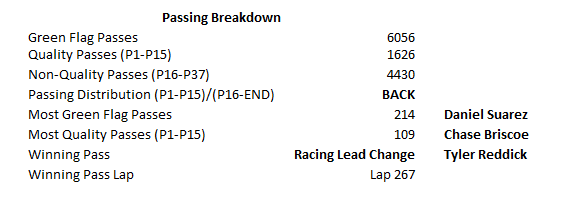
So Why So Good?
That’s one of the interesting things about statistics. Sometimes they can answer the questions, other times they just generate more. This is one of those cases.
Take for instance-Las Vegas the previous week had nearly identical numbers -4 RLCs, 217 Racing Laps, 54 Racing Laps/RLC, 5 cautions versus 6. Both had the bulk of their Green Flag Passes in the back at nearly identical rates. Neither had GWC finishes.
A lot of similar metrics.
One was a fuel mileage race. Another was a race. One got a 65.9% in the “Good Race” Poll while the other was 93.8%. Why the difference? Why was Homestead the Greatest. Playoff. Race. Ever?
I think there was several things that contributed to that opinion. PRN’s Doug Rice maybe summed it up best in his appearance on “Door Bumper Clear”, when he compared racing to gymnastics and said if you don’t stick the landing, no one remembers the rest of your performance.
At Homestead, Reddick most definitely stuck the landing. Not pitting when others did on that final stop to gain track position, to roll off on used tires, to lose the lead to Denny Hamlin and get in a dogfight with Chase Elliott, while Hamlin and Ryan Blaney drove away. To get back into the mix when Blaney battled Hamlin for the lead and then take the low groove to get by Hamlin and then take the open top lane on the final turns to get by Blaney for the win… if it wasn’t a 10, was pretty darn close.

So maybe that’s what got it the Greatest moniker.
Or maybe it was that final run. It ran the advertised length. No overtime. Natural. Not a gimmick. Longer than a GWC to give them time to race, but short enough where they couldn’t get strung out. Or maybe it wasn’t the number of RLCs but the timing. To have half the race’s RLCs occur in the final two laps is definitely more memorable, unlike say Bristol 2 that only had 1 RLC and it happened in the first 33 laps of a 500-lap race. Is it the timing that makes it the Greatest? Then what about the fact that there were no RLC’s in the first 160 laps of the race? Do those at the end outweigh the drought at the beginning?
I’m not sure. I know that for me it was a good finish. I wished Blaney had of moved up about half a lane in the final turn and not giving Reddick a clear shot at his preferred lane. Watching him get past the #12 for the win in that scenario would have elevated the race status even higher.
We can only imagine.
So was it the Greatest. Playoff Race Ever? Maybe. Based on the stats, I’m not ready to give it the title.
Plus, we have Martinsville just ahead. Maybe, just maybe that will take the crown.
Wouldn’t that be something? Tune in and let’s find out. Till then…
Thunder On… and Stay Safe!
David Nance
Photo Credit (cover): James Gilbert/Getty Images)



Thanks, David, for some very interesting reading.
Like you, I am not quite ready to give it the title of greatest playoff race ever. IMO, Tyler passed Ryan when Ryan screwed up and gave Tyler the lane that was most beneficial to Tyler. Ryan had been using the high lane, but then took the lower lane and that gave Tyler an advantage. Would have been different, I think, if Ryan had taken and stayed in the upper lane. Again, jmo…
Stats continue to amaze me. And so do you, to track things so well and then give us a lot of information most of us were not aware of.
Thank you again. Take care and stay safe
Thanks Vivian!
I’m still mystified why Ryan didn’t run a half lane higher? That would have sealed the Top and put him in position to seal the middle. Would have used up more track and I’m not sure Tyler would have expected that.
But it all worked out. Ryan got Martinsville.
Odd how the three winners in Round 3 came
From below the cut line.
Oh those Playoffs.
Who do you have this week?
Good question.
I would like to see Ryan win again, but I am just not sure. I think maybe Tyler has a good chance to take it. I am not sure Joey or Byron can pull it off.
Yes, it is odd they all came from below the cut line
We still have racers and we still have drivers. I think they all 4 are racers
And having all 4 as racers is a blessing!